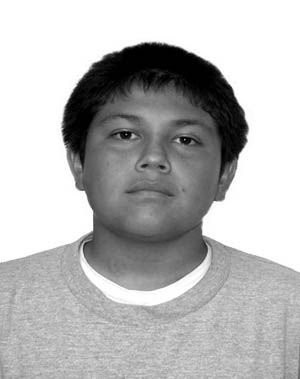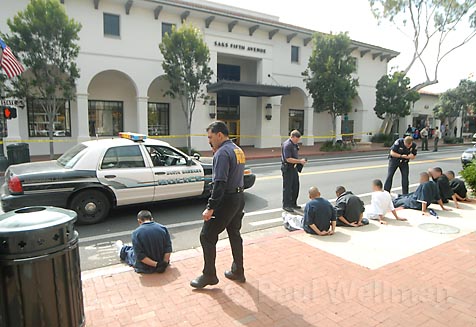Attorneys Give Opening Arguments in Juarez Gang Murder Trial
Knifing Not Gang Related, and Another Teen Struck the Fatal Blow, Defense Claims
As the trial of 15-year-old Ricardo Juarez commenced, on August 6 in the courtroom of Judge Brian Hill, prosecutor Hilary Dozer described his opening argument as a “roadmap” of the events leading to the murder of Luis Angel Linares in spring of 2007. Senior Deputy District Attorney Dozer emphasized the premeditation of the Eastside gang, of which Juarez is a member, as they prepared, on March 13, to converge on State Street the following day and “bang for the Eastside.” Linares, who lived on the Westside of town, was 15 years old when he died in the March 14 melee. Juarez, standing trial for murder as an adult, was 14.

The jury, composed of 11 women and five men, of whom one woman and three men are alternates, was told by Dozer of a “perfect storm” of young people gathering on State Street, shortly after noon when school let out, early, for staff meetings. With the help of evidence photos, Dozer emphasized the violent intentions of the Eastside Traviesos, the younger auxiliary of the Eastside gang to which he said Juarez belonged. He showed “the big one”–the knife that Juarez used–along with bottles, bats, and sharpened stakes also found at the crime scene. “The defendant was prepared to kill with the big one,” said Dozer, “and planned to kill anyone from the Westside.”
Dozer said the Eastsiders involved in the fight belonged to a criminal gang whose primary activity is “assaultive behavior.” With the help of MySpace photos, which defense co-counsel Jennifer Archer attempted to remove from the body of acceptable evidence, the prosecutor placed defendant Ricardo Juarez in the midst of this gang culture, showing him clad in the gang’s preferred blue with groups of other gang members who were, like Juarez, also displaying the hand signs for Eastside. There was also a photo of Juarez alone, wearing black gloves that Dozer explained were worn to mask evidence of a fight including wounds and blood. Before the jury came into the room, Archer argued that not only were the photographs from an anonymous source, but they also could have been altered digitally to remove or add people to the image. Judge Brian Hill allowed the photos with the understanding that prosecutor Hilary Dozer would reveal the identity of their source during the course of the trial.

Dozer gave his version of events using slang such as “homies” and what he characterized as gang monikers for the defendant and others involved in the fight (Juarez is called “Lil Thief” and the victim “Nacho”), in what seemed like an attempt to portray the Eastside gang to the jury in vivid and startling detail. The prosecutor physically demonstrated several parts of the action. He told the jury about how Juarez ran across State Street with his “big one” drawn, and slashed at the victim, Luis Linares, who was standing on the corner of State and Carrillo Streets in front of Saks Fifth Avenue. Dozer showed how Linares reportedly fell down, crab walked away from Juarez, and got up to run away, exposing his back, where he would receive the fatal blow, though the prosecutor did admit that the forensic team could not chronologically sequence the seven wounds ultimately found on Linares’s body.
Dozer closed by bringing up one of the more problematic, yet important, pieces of evidence in the trial: the “Whisper Tapes.” The “Whisper Tapes” is a video recording of a whispered conversation, which lasted several hours, between Ricardo Juarez and fellow Eastsider Jose M. while the two were in a police station holding room. Because the conversation is whispered, the tapes are difficult to understand and interpret. Dozer quoted a segment in which Juarez reportedly told Jose, “They [the police] already know everything. They knew it was me.” He quoted Juarez later telling his friend that he had seen blood coming out of the victim’s mouth, something that Dozer explained would only happen had Linares sustained an injury, like the fatal one, which would cause severe internal bleeding. Finally, Dozer closed his argument with a quote that he seemed to hope would convince the jury of Juarez’s intent to murder:
Jose M.: “Do you think doing this for the Eastside is worth it?”
Juarez: “It would have been if I hadn’t been caught.”
The defense co-counsel, Deputy Public Defender Jennifer Archer, began her opening argument by addressing the jury directly, saying she wanted to start by “acknowledging you, acknowledging your challenges,” and saying that the jury would have to “reconcile some very difficult truths.” She continued by saying that she was not presenting a “roadmap” as prosecutor Dozer had, but a story for which her opening argument would be the “outline.”
“You haven’t heard the half of it,” Archer pointed out as she displayed a photo of a boy on the overhead projector. This boy was not Ricardo Juarez, but Ricardo Romero, Archer explained, another person to play a role in this “story with a complicated plot and vulnerable characters.” Also, it was a story with two main characters sharing the same name: Several times Archer used “Ricardo” to refer to Juarez or Romero, and had to be reminded by the judge to use last names.
Archer retold the events of March 14, emphasizing Linares’s role as an active rather than a passive one. “He was courting trouble and violence,” said Archer, describing Linares on State Street that day with his bicycle, and pointing out that when Juarez ran at him with a knife, he did not ride away, but chose to stay.
Archer continued by painting a new side of Juarez to the jury, the more sympathetic side, the side that prosecutor Dozer had neglected to share. According to Archer, Juarez was not really a trouble-maker, he was a young person in love, and he was called “L’il Thief” merely in reference to his cousin who was called “Thief.” With this new characterization of Juarez in mind, Archer introduced the second Ricardo, also called “Stomper,” into her narrative. Archer told the story of how Stomper also came to State Street that day, wearing his “costume” of Eastside blue with black gloves, like Juarez’s, and how he escaped whereas Juarez was caught.
“This is the story of an investigation,” Archer added, promising to illuminate for the jury mistakes and assumptions made by the police who were involved in apprehending the young people and collecting the evidence at State and Carillo Streets that day. Archer warned the jury that local police officers would say that this was a gang crime, but that the jury members must “use extra caution” on this point because the defense intends to prove that the Eastsiders were “not a gang” under the definition of the penal code, and that in any case Juarez did not act with specific intent to benefit a gang.

Archer explained that Juarez had received phone calls saying his girlfriend had been spat on and pushed that day on State Street. Archer pointed out that the Westsiders had been throwing rocks on the afternoon of March 14, and that when Juarez ran across the street, waving his “prop” (the knife), he was doing so with “drama” and “bravado” in defense of his girlfriend. Archer told the story of how Juarez was showing courage and bravery as he confronted and chased Westsider Linares, but his fear got the best of him and he fled.
This is where Ricardo Juarez’s story ended, and Ricardo Romero’s (or Stomper’s) story began, according to Archer. In the back parking lot of Saks, Stomper stabbed Linares in the part of his back where the coroner later identified the fatal wound, according to several witnesses, Archer claimed, adding that “the evidence will show Stomper killed Linares.” Stomper got away, shed his gloves that had Linares’s blood on them, and gave them to a friend to be stashed. He went to the Eastside Boys and Girls Club and told someone he had just killed another boy. Of all the witnesses to the events that took place in the back parking lot of Saks where Linares was found dead, none of them identified Juarez, emphasized Archer.
The defense promised to prove that, while Juarez is responsible for several “superficial” and non-life threatening wounds on Linares, he was not the one to give the lethal blow. According to the forensics team, had Juarez dealt Linares the fatal blow on State Street, it would have taken “a Hurculean effort” to run the way Linares was seen running from the front to the back of Saks. Archer told the jury that they have to “find [Juarez] responsible for what he is responsible for,” not what other alleged gang members are responsible for. Also bringing up the “Whisper Tapes,” Archer also pointed out parts of the conversation different from those that Dozer picked. Archer described a part of the tape in which Jose M. told Jose, “Stomper got Nacho,” while gesticulating to the part of his back where Linares received the fatal stab wound. Archer closed by telling the jury, “you are the resolution of the crisis” of this story.
Having concluded the opening arguments, prosecutor Dozer examined his first witness, Officer Christopher Zbinden, the policeman who was the first to the scene and responsible for breaking up much of the fight. Deputy Public Defender Karen Atkins began her cross examination, but did not have time to finish. The trail is scheduled to resume court on Friday, August 8 at 9:30 a.m.



